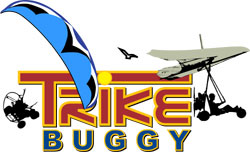

On Friday, May 17, 2009, I got the opportunity to test fly the new four-stroke Thumper motor mounted to a TrikeBuggy Transformer frame flying the North Wing Stratus trike wing at the El Mirage Ultralight Aircraft Flight Testing Grounds.
"The engine is 100% stock (no hotrod parts), so engine parts and repair can be accessed where ever you are, and far into the future. The engine we use is not over-worked and we limit the RPM to increase longevity. The important features about 4 strokes are their potential for longevity, reliability, low noise, ease of repair, and very low fuel use. Compared to 2 strokes, the 4 stroke is perfect for flyers who do not wish to learn to perform engine repairs and tuning. 2 stroke engines have a reputation for quitting at the wrong time..not a good thing when you're on a cross-country flight far from your car. The Thumper also comes with a very reliable propeller speed reduction system." Starting this motor is as simple as turning the key, and the electric start breathes life into the Thumper. When the engine is idling, you can hold a normal conversation while standing right next to it, it is so quiet! Bring the RPM up to 3800, and you have the sound of the GSC 3-blade 62" propeller moving some serious air. Seating is comfortable in the TrikeBuggy Transformer, as there is a back support along with the cloth seat suspended from the stainless steel trike frame. This seat buffers some of the vibration from the mighty 4-stroker, as it is a fairly heavy motor. Wrap-up is slightly slower than the MZ-34 (313cc Compact Radial motor), but the thrust becomes immediately evident, as the large prop grabs some serious air. I was able to launch using only about 2/3 throttle, engine RPM around 3800 and air speed of right around 28 mph. I did not change the position of the Hang Block from the setting installed at the factory, it worked just fine.
The pilot barely needs a ear protective headset, as the motor has a pleasant low timbre sound similar to that of a car's engine runing. Cruising with this trike is very pleasant for a variety of reasons:
From the moment you unzip the Stratus, you can see the quality of construction used by North Wing on this extraordinary wing. Set up is straightforward, and while there are more battens than the Wills Wing Falcon 225, the wing is a very different animal as a result. It is a true double surface glider, with the cross tubes completely covered by the very smooth lower surface of the glider. There are 11 upper ribs (battens) and 4 lower surface ribs, and once this glider is assembled and tensioned, it looks sleek and tight. The rear wires are abbreviated, made for use with a trike, and it comes with the split shaft collars already installed and ready for the Hang Block.
It was simple to attach the trike to the TrikeBuggy Delta, and lifting the 84 lb glider to the ready position is easily done by one person using wheel chocks behind the rear wheels of the trike. After installing the front compression strut and tightening the bolts, I am ready for Preflight and first flights! I was surprised at how quickly the trike began flying after starting the takeoff run. I was expecting a much longer roll-out, but this combination of motor thrust and glider efficiency caught me off guard. I was in the air so quickly and everything was so well balanced, that I could hardly believe that I was flying. It felt very solid and perhaps heavy, compared to what I am used to, but the glider was just a joy to fly. The speed range is truly remarkable, as I played with touch and go practice for about an hour. Flare timing is very intuitive with this wing, and the retained energy lets you skim the ground in ground effect almost effortlessly. One of the seasoned pilots from the Flying J Ranch commented on the wing after seeing it from the air. He said that it looked like a very high performance wing and was impressed with the smooth surface and sleek lines of the glider. He thought it looked like a "knife" just waiting to cut the air! |
||||||||||||||||||||||||||||||||||||||||||||||||||||||
|
|---|
|
DISCLAIMER: Please read and be sure you thoroughly understand this disclaimer before flying a TrikeBuggy. Trike flying is an extremely demanding sport requiring exceptional levels of attention, judgment, maturity and self discipline. It is unlikely that you will be able to participate in it safely unless you make a conscious and continual commitment to your own safety. PPG and Hang Glider Trike flying is a dangerous sport and may result in injury and death even when practiced by a competent pilot using proper equipment. TrikeBuggies are not covered by product liability insurance, nor have they been designed, manufactured or tested to any federal or state government airworthiness standards or regulations. Do not fly them unless you are willing to assume personally all risks in the sport of Trike flying, and all responsibility for any property damage, injury, or death which may result from your use of this TrikeBuggy. Safe operation of the TrikeBuggy requires a pilot proficiency equivalent to that of a BFI (Basic Flight Instructor), as well as an equivalent level of knowledge and understanding of those wind and weather conditions which may compromise the pilot's safe control of the TrikeBuggy. In particular, be advised that gusty winds or turbulent conditions may interfere with even an expert pilot's ability to safely control the TrikeBuggy, and may cause it to crash. Never take anything for granted in Trike Flying. If you are in doubt about anything, stop and figure it out or contact TrikeBuggy. Also please read our Warning and Caution! |